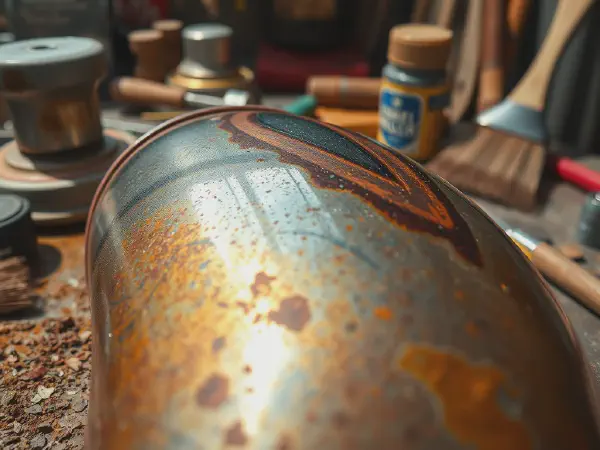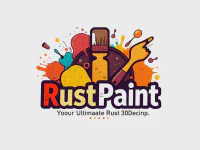Top Tips for Rust Restoration: Bring Your Metal Back to Life

Rust Restoration: A Comprehensive Guide
Rust Restoration is an essential process that revives and extends the lifespan of metal objects affected by rust. Rust, which is a result of corrosion, can weaken structures, reduce aesthetic appeal, and even render items unusable. Rust Restoration involves cleaning, repairing, and protecting metal surfaces using various techniques and tools. This guide explores the methods and best practices for effective rust restoration, ensuring metal items regain their original glory.
Understanding the importance of Rust Restoration is crucial, as rust can compromise the integrity of metal materials, leading to safety hazards and costly replacements. By investing in rust restoration, you not only restore the functionality of these items but also prevent further damage. Whether it’s tools, vehicles, furniture, or machinery, proper rust restoration ensures that items remain in usable condition while enhancing their visual appeal. Moreover, timely intervention can save money and resources in the long run by prolonging the life of metal products.
Rust Restoration can be undertaken using various techniques depending on the extent of rust damage. Some common methods include chemical sprays, sanding, and more advanced processes like electrolytic removal. The key to a successful restoration lies in selecting the appropriate method, understanding the material, and applying various protective measures post-restoration to keep rust at bay. Consistent maintenance and environmental control can also play a significant role in preventing rust from reappearing.
For those considering a DIY approach, Rust Restoration can be a rewarding project. However, having a clear plan and the right tools is vital. From simple home projects to more complex restorations for vehicles and antiques, many techniques can be applied to restore rusted items effectively. It’s essential to follow safety protocols while working with rust removal substances and tools to avoid injuries and ensure a successful restoration process. This guide will provide comprehensive insights into all aspects of rust restoration.
In addition to DIY efforts, many professional services specialize in Rust Restoration. Hiring experts can not only guarantee a high-quality finish but can also save time and reduce the risk of mistakes. It’s crucial to assess the qualifications, costs, and previous project results of these services before choosing to ensure that you receive the best care for your rusted items. With proper understanding and execution of rust restoration techniques, you can reclaim the beauty of rust-affected objects.
Rust Removal Techniques
Chemical rust removers are a popular choice for Rust Restoration due to their effectiveness and ease of use. These products typically contain acids or chelating agents that dissolve rust when applied to the affected surface. Users must follow the manufacturer's instructions carefully and take safety precautions, such as wearing gloves and masks, to protect themselves from harmful fumes and substances. After application, the surface should be rinsed thoroughly and treated with a protective coating to prevent future rusting.
Effective techniques for Rust restoration can rejuvenate old vehicles, preserving their beauty and extending their lifespan.
Mechanical rust removal methods involve physical methods like sanding, grinding, or wire brushing to remove rust. While these techniques can be labor-intensive, they are effective for thicker rust layers. Sanding can be direct or done with the aid of machines, and it’s vital to choose the right grit sandpaper to avoid damaging the metal surface. Once the rust is mechanically removed, it’s critical to clean the surface thoroughly to prepare it for protective measures.
Natural rust removal solutions have gained popularity for those seeking eco-friendly methods. Ingredients like vinegar, baking soda, and lemon juice can be combined to create non-toxic rust removers. Applying these solutions can effectively dissolve rust over time, though they may require a longer application period compared to chemical products. After using natural solutions, it’s important to rinse and dry the items properly to avoid leaving residues that may foster future rust.
Electrolytic rust removal is a more complex but effective method that uses electrolysis to remove rust without damaging the base metal. This technique requires a power supply, electrolyte solution, and a sacrificial anode to facilitate rust removal. The rusted item is submerged in an electrolytic solution with the anode and cathode connected to a power source. The rust is effectively pulled from the metal surface, leaving it clean and ready for further treatment or painting.
Sandblasting is another effective technique for rust removal, especially for larger metal surfaces. This method involves blasting abrasive materials at high pressure to remove rust and surface debris. It’s particularly useful for industrial applications and vehicles. Though effective, sandblasting requires specialized equipment and safety measures to prevent injury or damage to the surrounding area from flying debris. Proper care and consideration should also be given to the material being blasted to avoid excessive wear or damage.
Preventive Measures for Rust
Choosing rust-resistant materials is one of the most effective preventive measures against rust. When constructing or selecting items, opt for metals like stainless steel or galvanized steel, which include protective coatings that inhibit corrosion. Opting for rust-resistant alloys in manufacturing can also enhance the longevity of metal products, making them more reliable against rust damage.
Applying protective coatings such as paint, sealants, or clear coats creates a barrier against moisture and environmental factors that lead to rust. It’s essential to prepare the surface adequately before applying any coating to ensure proper adhesion and effectiveness. Regular inspections and maintenance of these coatings are crucial to ensure they remain intact and effective in preventing rust formation.
Regular maintenance tips, such as cleaning and inspecting metal items routinely, can significantly reduce rust risks. It’s important to remove any dirt, grime, or moisture from surfaces and examine for any signs of rust early on. Treating rust spots promptly can prevent them from spreading and reduce the need for extensive restoration work in the future.
Environmental control is critical in preventing rust. Ensuring the storage environment for metal items is dry and well-ventilated minimizes moisture buildup that fosters rust. Utilizing dehumidifiers, proper insulation, and arranging items in a way that promotes air circulation can drastically reduce the likelihood of rust formation. It’s also wise to avoid storing metal items directly on concrete surfaces, which can attract moisture.
Using corrosion inhibitors is an effective measure to protect metal surfaces from rust. These chemical compounds create a protective film over the metal, preventing moisture and oxygen from reaching the surface. Different inhibitors are available depending on the application and type of metal, and many can be easily applied as sprays or included in manufacturing processes. Regular reapplication may be necessary to maintain protection levels against rust.
Tools and Equipment for Rust Restoration
Rust restoration requires various tools and equipment to achieve effective results. Basic tools include wire brushes, sandpaper, power drills, and chemical removers. An effective rust restoration toolkit should also consist of safety gear, including gloves, masks, and goggles, to ensure safe handling when working with rust-removing products and tools.
Choosing the right sandpaper is essential in rust restoration to prevent damage to the metal surface. Beginners should start with coarser grit papers (like 80 or 120) for heavier rust and transition to finer grits (like 220 or 320) for smooth finishing. The choice of paper can influence the success of the restoration process, as using the incorrect grit could result in scratches or gouges that detract from the finished appearance.
Essential safety gear for rust restoration includes personal protective equipment such as gloves, dust masks, and safety goggles. This gear is vital in protecting the face and eyes from harmful chemicals, dust, and debris generated during the restoration process. Ensuring safety gear is worn consistently throughout the project reduces the risk of injury and health issues associated with rust removal products.
Power tools, like electric sanders, angle grinders, and pneumatic tools, can significantly enhance the effectiveness of rust removal. These tools allow for a faster and more efficient restoration process, especially for large surfaces or heavy rust. It’s crucial to use power tools according to safety guidelines and manufacturer instructions to avoid accidents and ensure proper operation.
Cleaning and preparing tools for restoration is an essential step in ensuring effectiveness and longevity. After each use, tools should be thoroughly cleaned to remove rust or chemicals, which can cause further corrosion. Regular maintenance, such as oiling metal parts and checking for wear, maximizes the tool’s life and performance during restoration efforts.
DIY Rust Restoration Projects
A step-by-step guide for home DIY projects on rust restoration typically begins with evaluation. Identify rusted areas, assess the extent of damage, and gather the necessary tools and materials. The following steps might include cleaning the surface, choosing a rust removal technique, applying rust inhibitors, and finally, coatings for protection. Documenting each step can help ensure effective outcomes and make future restorations easier.
Best practices for DIY rust restoration include working in a well-ventilated area, following safety protocols, and carefully planning the process. Make sure to read and follow instructions for any chemical products used, and take ample time to work through tougher rust areas to avoid causing damage to the underlying metal. Maintaining a tidy workspace also ensures safety and efficiency throughout the project.
Upcycling rusted items into decor can be a creative and sustainable way to address rust damage. Items like old buckets or tools can be transformed into unique home decor pieces with some cleaning and a coat of paint. Framing rusted gears or incorporating them in garden setups can add an artistic touch while showcasing vintage appeal.
Using rust restoration techniques on vehicles often requires specialized knowledge and tools. Begin by assessing rusted areas on the vehicle, sanding down affected spots, and applying appropriate rust removers. Following restoration techniques, reapply paint or protective coatings to prevent future rust buildup. It’s recommended to consult automotive restoration guides or professionals for best practices, as procedures may differ for various vehicle models.
Tips for restoring antique metal items with rust include researching the correct restoration techniques for specific metals, as some may require gentler methods to preserve their value. It’s vital to handle antiques with care and opt for cleaning solutions that will not strip away patina or original finishes. Leverage professional advice or refer to specialized literature for the best approaches for antique restorations.
Professional Rust Restoration Services
When seeking a rust restoration service, look for qualifications, experience, and customer reviews. Assess whether the service specializes in the metal type and restoration needed. Asking for a detailed quote and reviewing previous work or portfolios can also provide insight into the service's capabilities and quality.
Costs associated with professional rust restoration services can vary widely based on factors like the extent of damage, size of the item, and materials needed for restoration. It's essential to get multiple quotes from various services to ensure a fair price. Understanding the breakdown of costs involved can help make informed decisions when selecting a service.
A comparison of in-house vs. mobile restoration services can direct you to the best option for your needs. In-house services might provide more comprehensive capabilities and specialized equipment, while mobile services offer convenience for larger items. Weighing your circumstances and the specific needs of the restoration process can help you choose the most efficient approach.
The benefits of hiring professionals for rust restoration include their expertise, access to specialized tools, and efficiency in handling complex restorations. Professionals can also assess the extent of damage accurately and recommend appropriate treatments that individuals may overlook. Their experience in overcoming unique challenges ensures high-quality results.
Reviewing past projects of rust restoration services is key to understanding what to expect. Look for before-and-after photos, customer testimonials, and ratings on independent platforms to assess the service's reputation. This information can help validate their capabilities and make an informed choice when selecting a rust restoration company.
